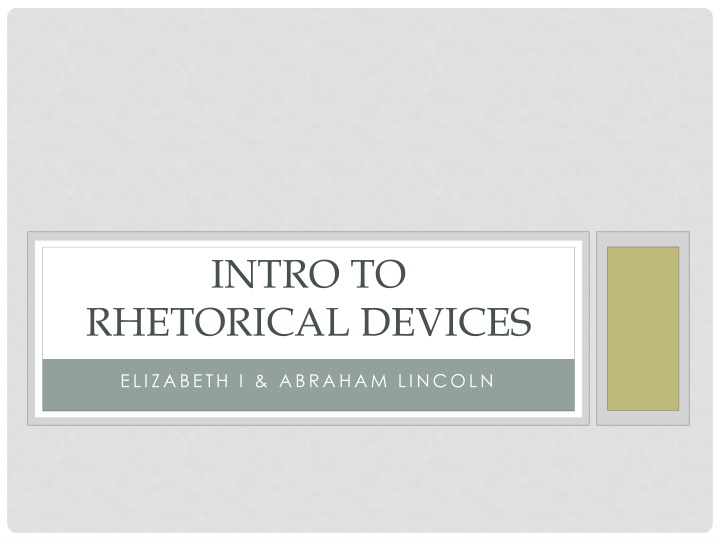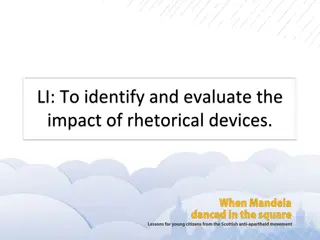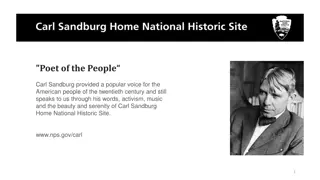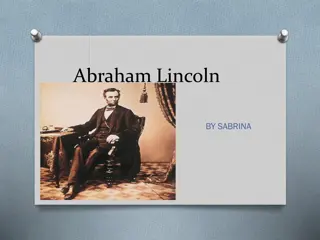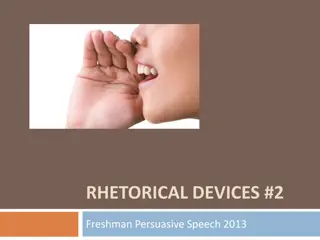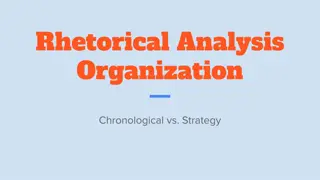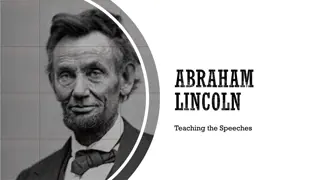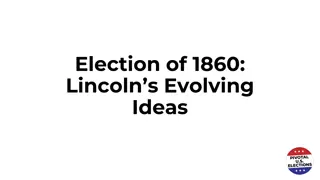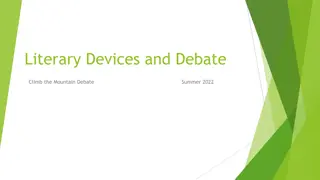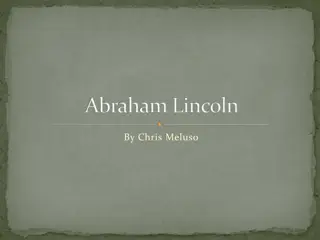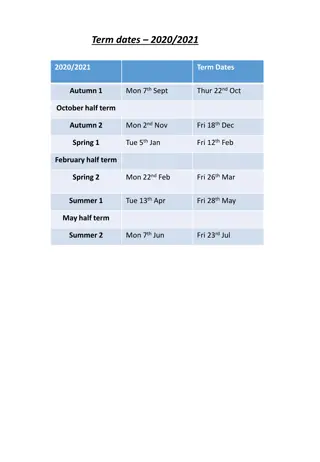Rhetorical Devices in Speeches of Elizabeth I and Abraham Lincoln
Explore the use of various rhetorical devices such as imagery, diction, connotation, denotation, metaphor, analogy, juxtaposition, antithesis, parallelism, repetition, and polysyndeton in the speeches of Queen Elizabeth I and President Abraham Lincoln. Witness how these rhetorical techniques enhance the persuasive power and emotional impact of their words.
Download Presentation

Please find below an Image/Link to download the presentation.
The content on the website is provided AS IS for your information and personal use only. It may not be sold, licensed, or shared on other websites without obtaining consent from the author.If you encounter any issues during the download, it is possible that the publisher has removed the file from their server.
You are allowed to download the files provided on this website for personal or commercial use, subject to the condition that they are used lawfully. All files are the property of their respective owners.
The content on the website is provided AS IS for your information and personal use only. It may not be sold, licensed, or shared on other websites without obtaining consent from the author.
E N D
Presentation Transcript
INTRO TO RHETORICAL DEVICES ELIZABETH I & ABRAHAM LINCOLN
FAMILIAR WITH Imagery Diction Connotation Denotation Figurative language Analogy Metaphor
JUXTAPOSITION The fact of two things being seen or placed close together with contrasting effect. helps make a logical appeal Elizabeth I We have been persuaded by some that are careful of our safety but I assure you I do not desire to live to distrust my faithful and loving people (Lines 2-3) Abraham Lincoln Second Inaugural Address vs. First, four years earlier Both parties deprecated war, but one of them would make war rather than let the nation survive, and the other would accept war rather than let it perish (Lines 18-20)
ANTITHESIS a person or thing that is the direct opposite of someone or something else. used to make a logical or emotional appeal Often a contrast in diction (hot is the antithesis of cold) Lincoln While the inaugural address was being delivered from this place, devoted altogether to saving the Union without war, insurgent agents were in the city seeking to destroy it without war (Lines 15-17)
PARALLELISM repeated syntactical similarities introduced for rhetorical effect used for emotional and logical appeals Elizabeth I I myself will take up arms, I myself will be your general (Lines15-16) Lincoln Parallelism galore in GETTYSBURG ADDRESS (just wait ;-)
REPETITION is the simple repeating of a word, within a sentence, phrase, or larger text, with no particular placement of the words, in order to provide emphasis used to make an ethical or emotional appeal Elizabeth I to lay down for my God, and for my kingdom, and my people, my honour, and my blood (Lines 9-11) not doubting but by your obedience to my general, by your concord in the camp, and your valour in the field (Lines 21-22) Lincoln Paragraph 3, repetition of plural pronouns at beginning of sentence Neither, Each, Both Shows unity
POLYSYNDETON The use of several conjunctions in close succession Increases the rhythm of prose (speeds or slows its pace) Creates a childlike enthusiasm Creates a sense of being overwhelmed Elizabeth I to lay down for my God, and for my kingdom, and my people, my honour, and my blood (Lines 9-11)
ANAPHORA Specific type of repetition Repetition of one or more words at the head of consecutive phrases, clauses, or sentences Used to make an emotional appeal Lincoln With malice toward none, with clarity for all, with firmness in the right as God gives us to see the right (Lines 54-55) to bind up the nation s wounds, to care for him who shall have borne the battle and for his widow and his orphan, to do all which may achieve and cherish (Lines 56-57)
CHIASMUS A reversal of grammatical order from one phrase to the next (think mirror image) Used to make an emotional or logical appeal Lincoln but let us judge not, that we be not judged (Lines 36-37)
ALLUSION an expression designed to call something to mind without mentioning it explicitly; an indirect or passing reference. Used to make an ethical, emotional, and/or logical appeal Lincoln but let us judge not, that we be not judged (Lines 36-37) Paraphrased Matthew 7:1 Paragraph 3---Biblical Allusions (ethos)
SAMPLE THESIS Queen Elizabeth I vows to live and die amongst her people even though she is merely a weak and feeble woman, and as a result, she humbles herself to her people.
TIPS FOR THE ANALYSIS 1. Address the prompt 2. Make a claim about the purpose/exigence of the essay. What do they want and how do they do it? 3. Establish how they do this with specific examples of rhetorical devices/diction/syntax. 4. Don t show the reader how well you know the rhetorical terms, show them how well you can analyze the essay. You must show that you get it. 5. Fully develop your claims (what)/warrant (how)/impact (why). 6. Use the essay. 7. Tie ideas/points back to your thesis/claim.
